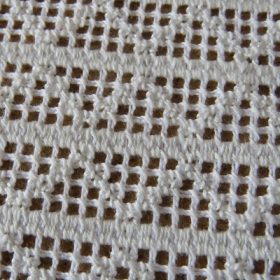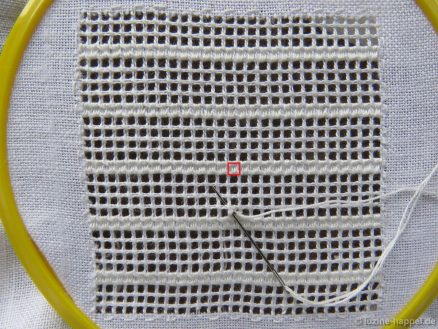Filling Pattern – No. 558
category: openwork filling pattern with Cable stitch grid
linen used: 13.5/cm thread count
threads used: coton à broder No. 30 for the Cable stitches and No. 20 for the Needle-weaving and the Rose stitches
stitches used: Needle-weaving and Rose stitches
center: intersection of withdrawn thread lines (square)
one pattern segment: 24 threads
The filling pattern shown here is a practice exercise only. You can see it used in a shape at the end of this article.
First, establish an openwork grid with a square (an intersection of withdrawn thread lines) in the center by cutting 2, leaving 2 both vertically and horizontally.
Stabilize the established grid with Single Faggot stitches worked from the back side of the fabric. Please remember that Single Faggot stitch worked on the back side will look like Cable stitch viewed from the front.
Work Needle-weaving stitches over one square
along the horizontal center axis.
Work parallel rows of Needle-weaving stitches with four empty squares between
until the entire shape is filled.
Work Rose stitches starting in the fourth square below the center square at the vertical center axis.
Starting with four stitches diagonally left and upward, work them in a zigzag manner between the two rows of solid Needle-weaving stitches.
Continue with three stitches diagonally downward to the left.
Work the stitches in the next open area mirrored to those of the previously worked areas.
When the entire shape is filled, a nice pattern is established.
Two variations are to use only Rose stitches or only Needle-weaving stitches. This would change the appearance a little bit.
I discovered this pattern on a pillowcase from about 1860.
It is also possible to adjust the zigzag lines so that they are not mirrored.
In traditional Schwalm whitework, this pattern, and its several variations, was popular for filling basket motifs.
















Leave a Reply